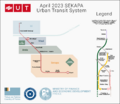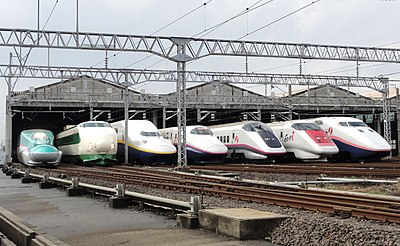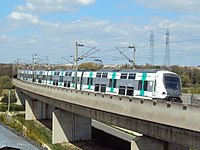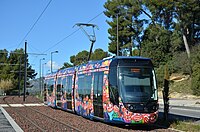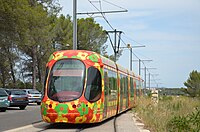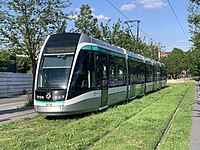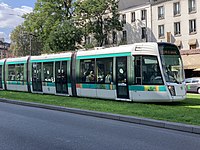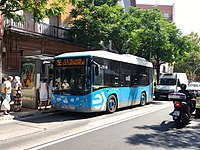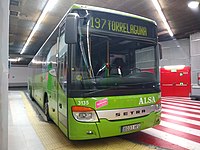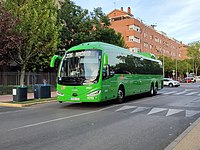United Trenchways: Difference between revisions
m (→Buses) |
(Updated Volton maps) |
||
| (28 intermediate revisions by 3 users not shown) | |||
| Line 2: | Line 2: | ||
{{Infobox company | {{Infobox company | ||
| name = United Trenchways | | name = United Trenchways | ||
| logo = File: | | logo = File:UT_Logo_2023.png | ||
| type = | | type = | ||
| industry = | | industry = | ||
| Line 8: | Line 8: | ||
| predecessors = | | predecessors = | ||
*[[East Side Railways]] | *[[East Side Railways]] | ||
*[[Conrail | *[[Conrail]] | ||
*[[Guri Subway]] | *[[Guri Subway]] | ||
*[[Portington Trenchway SL]] | *[[Portington Trenchway SL]] | ||
| Line 32: | Line 32: | ||
[[United Trenchways]], also called '''UT''', is a multinational corporation composed of several infraestructure and transportation builders and operators with hub in [[Guri]]. The company was created in 1972 and today encompasses over 54 different societies across many transportation and infrastructure-related fields. | [[United Trenchways]], also called '''UT''', is a multinational corporation composed of several infraestructure and transportation builders and operators with hub in [[Guri]]. The company was created in 1972 and today encompasses over 54 different societies across many transportation and infrastructure-related fields. | ||
UT originated as | UT originated as part of a major rebranding and restructuring effort undergone after the [[Peaceful Revolution]], in hopes that the unification of most rail transport providers under a single banner would fix the monopoly situation over several connections whivh severely limited operability across the country. | ||
The company | After its initial stagnation due to intense restructuring and bureaucratic processes, UT would quickly become a resounding success both culturally and economically, solving many of the issues existing before its conception and providing the nation with a realiable rail transportation system. | ||
UT's success would turn it into a major corporation within decades via the usage of the now controversial [[Ferrier System]]. The method, which saw the development of uncountable real state developments by where rail infrastructure would later occur, soon became the main source of income of the company. This model, widely considered as the origin of the company's success, lead the company into a rapid internationalization period, establishing subsidiaries in a number of countries. | |||
<!--eventually going on to provide service to many destinations nationwide, later including international routes on its list of clients as public transportation grew larger and larger in the mainland. --> | |||
United Trenchways allied with [[Ferrocarriles Nacionales de Anáhuac]] in the early 2000s to create the [[Standard Eastern Rail]]; a set of norms and indications meant to unify individual railway legislation across the eastern hemisphere, in hopes to have a more cohesive and adaptable railway industry. The SER manuals have evolved to regulate things as simple as numbers of cars on trains, to the amount of bolts to use on each pantograph or subway car door, which is said to have propelled the industry during the last two decades. This standardization manual has become the staple of modern railway normatives across the east, with nations such as [[Vultesia]], [[Freice]], [[Pohnpenesia]], [[Pacanesia]] and, although partially, the traditionally-western countries of [[Kentalis]], [[Gassasinia]] and [[Senefpat]], among others. | |||
The company is considered the largest rail transportation company worldwide, a title achieved partly due to its vast diversification process, although the claim is disputed because of this same diversification. Despite all this, UT has become the largest transport operator and infrastructure builder of [[Riamo]], operating more than 62 urban transportation networks across the country. Abroad, UT is currently responsible for operation and/or construction of rail-based projects across the globe, such as the expansion of [[Vinchina|Vinchina's Urban Transit system]] in [[Riojania]]; the L-2201 HSR line in [[Kentalis]]; the Cross-Negro shinkansen lines to [[Leogria]]; the renovation of former Imperial lines in [[Zona Umida]], construction of two internal high speed corridors and the operation of 7 urban transit lines in the country; the expansion of [[Freice|freician]] transit infrastructure; the construction of the Lines 10 and 12 in the [[San Jorge Xayacatlán Metro]]; and the current reconstruction of the [[Pohnpenesia|Pohnpenesian]] transportation infrastructure within the latest economic aid plans, among many others. | |||
<!--such as the current construction and/or expansion of 4 urban transit systems in [[Anahuac]],--> | |||
==History== | |||
===Conrail=== | |||
==Riamo== | |||
United Trenchways remains as the operator of the vast majority of transit systems in [[Riamo]], and currently operates as a state-backed operator across the country | |||
The following list includes a number of transit systems which United Trenchways has contributed to: | |||
<gallery> | |||
File:Volton 2023 Summer Edition - updated as of 2023-12-04.png|Volton after restructure in late 2023 | |||
File:Glowester Transit Map 2023-04-02.png|Glowester | |||
File:Harpan Transit Map.png|Harpan, [[Pohnpenesia]] | |||
File:Freice Transit Map.png|[[Freice]] | |||
File:Gukoshny Metro Map.png|[[Kentalis|Gukoshny]], [[Kentalis]] | |||
File:Boloney Transit Map.png|Boloney | |||
File:Vinchina Transit Map.png|[[Vinchina]], [[Riojania]] | |||
File:Volton 2023 Summer Edition - updated as of 2023-12-03.png|Volton as of Summer 2023 (deprecated) | |||
<!--File:Volton Transit Map 2023-04-01.png|Volton--> | |||
</gallery> | |||
==Subsidiaries and International Projects== | |||
The company currently holds concessions in 17 countries, the largest of which include: | |||
* [[Guri Metro]], [[Portington Metro]], and another 67 urban transit systems in [[Riamo]] | |||
* [[Sekapa Tram]] in [[Freice]] | |||
* [[San Jorge Xayacatlán Metro]] (partly) in [[Anáhuac]] | |||
===Gassasinian Trenchways=== | |||
Gassasinian Trenchways is a subsidiary of United Trenchways based in Gassasinia. It was founded in 1978 by [[Western Trade Company Railways]] through a partnership with the local government of Basra, a satellite city of Jabiyah which would later be amalgamated into New Jabiyah. The partnership saw Gassasinian Trenchways construct railway services from Jabiyah to Basra, in return for being allowed to take ownership of the land around the tracks. As of today, the Basra City Railway boasts 2 metro lines and 2 tramway lines. In 2003, the Basra City Railway, along with the privately owned New Jabiyah Subway and the Gassasinian Railways-operated Jabiyah Subway, agreed to form the Jabiyah Metro which introduced a unified ticketing system, uniform branding, synchronised time-tables and integrated maps. | |||
Since the liberalisation of the Gassasinian Railways rail network in 2008, Gassasinian Trenchways has provided a range of rail services as an open-access railway operator. Gassasinian Trenchways also operates services on a number of low-traffic unelectrified rural routes whose passenger operations have been outsourced. The TransMagrikia brand was introduced in 2012, providing budget-friendly high speed and intercity services. | |||
==Rolling Stock== | ==Rolling Stock== | ||
This list represents a comprehensive listing of all rolling stock produced by UT and its subsidiary companies, not necessarily the one UT operates. | This list represents a comprehensive listing of all rolling stock produced by UT and its subsidiary companies, not necessarily the one UT operates, ordered by [[Standard Eastern Rail]] train category nomenclature, with noticeable examples of each. | ||
===High Speed "Shinkansen" Rail lines=== | ===High Speed "Shinkansen" Rail lines=== | ||
| Line 53: | Line 96: | ||
</gallery>--> | </gallery>--> | ||
===Regional and Trenchway lines=== | ===Regional and [[Trenchway]] lines=== | ||
{| class="wikitable sortable" | {| class="wikitable sortable" | ||
|- | |- | ||
| Line 86: | Line 130: | ||
===Intercity "Closeway" lines===--> | ===Intercity "Closeway" lines===--> | ||
=== | ===Subway lines=== | ||
==Type and size== | |||
Following [[Standard Eastern Rail]] classifications, Subway/metro trains operated by United Trenchways come in two sizes, Type-B cars and larger Type-A cars, both of which are commonly used by other urban transit systems in countries that follow this classification, with Type-A cars being the larger one. Type-A cars have 5 pairs of doors per car, while Type-B cars have 4 pairs of doors per car. | |||
{| class="wikitable" style="text-align: center;" | |||
! | |||
! colspan="2"|Type-A car<ref>GB 50157-2013:地铁设计规范 (English: Metro Design Code).Ministry of Housing and Urban-Rural Development of the Riamese Federation.</ref> | |||
! colspan="2"|Type-B car<ref>{{Cite journal|author=Rao Guohua |title= Boloney Rail Transit Line 1 phase 2 metro vehicle|journal= Electric Locomotives & Mass Transit Vehicles|year= 2013 |volume= 036|issue=6 |pages=7–11 }}</ref><ref>{{Cite journal|author= Lu Hakin|title=Development of Boloney Rail Transit Line 2 vehicle|journal= Electric Locomotives & Mass Transit Vehicles|year= 2013 |volume=036 |issue= 1 |pages=5–8 }}</ref> | |||
|- | |||
! | |||
!Cab car | |||
!Non-cab Car | |||
!Cab car | |||
!Non-cab Car | |||
|- | |||
|Width | |||
|colspan="2"|3.0 m | |||
|colspan="2"|2.8 m | |||
|- | |||
|Length | |||
|23.6 m | |||
|22.0 m | |||
|19.3 m | |||
|19.0 m | |||
|- | |||
|Height | |||
|colspan="2"|3.8 m | |||
|colspan="2"|3.8 m | |||
|- | |||
|Capacity <br>(at 6 people/m<sup>2</sup>) | |||
|colspan="2"|310 people | |||
|230 people | |||
|245 people | |||
|- | |||
|Doors | |||
|colspan="2"|5 pairs | |||
|colspan="2"|4 pairs | |||
|} | |||
<!--{| class="wikitable sortable" | |||
|- | |||
! style="width:40%;"|Images | |||
! style="width:15%;"|Livery Name | |||
! style="width:25%;"|Usage | |||
|- | |||
| [[File:0159 entering Lianhua Road Station (20180211162025).jpg|200px]] [[File:A SFM18 in ZHANGGUOZHUANG Station.jpg|200px]] [[File:8000 metro madrid.jpg|200px]] | |||
| Type M8 trains (8 cars) | |||
| First type of standard Riamese metro train, 8 car version <br> Planned for lines predicted to have large passenger influxes <br> Pictures show FAC Liasz, Kutai Crystal 1060, and Metrya 5000 OT HERS LIKE Lotto L81 L85, Kutai Crystal 1060, and Metrya 5000 and FAC Liasz | |||
|- | |||
| [[File:Shanghai Metro Line9 AC04.JPG|200px]] [[File:A DKZ53 in ZHANGGUOZHUANG Station.jpg|200px]] [[File:Metro Madrid Bilbao (6840960822).jpg|200px]] | |||
| Type M6 trains (6 cars) | |||
| Second type of standard Riamese metro train, 6 car version <br> Planned for lines predicted to have lower usages. The M5 (5 cars) variation features even smaller trains, for the cases where estimates were higher than final passenger numbers, but remains a class not official on [[Standard Eastern Rail]] nomenclature and is no longer used <br> Pictures show FAC Molesz, Kitai Crystal 1080 and Metrya 4000 | |||
|- | |||
| | |||
| Type M4 trains (4 cars) | |||
| Third type of standard Riamese metro train, 4 car version <br> Pictures show Metrya 3000 and Metrya 4000 <br> Remains an unpopular classification among [[Standard Eastern Rail]] norms, with tramways or extensions of broader lines often chosen to fill the role instead | |||
|} | |||
{| class="wikitable sortable" | {| class="wikitable sortable" | ||
| Line 112: | Line 214: | ||
|} | |} | ||
<gallery> | <gallery> | ||
File:8000 metro madrid.jpg | Metrya 6000 series | File:8000 metro madrid.jpg | Metrya 6000 series | ||
| Line 123: | Line 225: | ||
===Surface "Tramway" lines=== | ===Surface "Tramway" lines=== | ||
While most classes are compatible with the A3 and A5, some, specially older ones, tend to present notable differences in aspects such as floor height and car lenghts, which can cause issues regarding their accessibility in some platforms, among others. | |||
Because of these problematics, A3 and A5 are hence the only 2 classes considered standard under current legislation, also being the only two classes allowed for new developments. The rest of classes are, as of 2022, on their way to being phased out across the country. | |||
{| class="wikitable sortable" | {| class="wikitable sortable" | ||
|- | |- | ||
| Line 183: | Line 289: | ||
===Buses=== | ===Buses=== | ||
Buses in [[Riamo]] work in 2 types of systems: | |||
The main urban bus, locally called "color" buses, are operated by often more than one company per urban area, whose color is relative to the urban area itself and helps as identificator to the city. They have urban routes and link other transit stations where there isn't reachability for faster types of transit. | |||
There are also "green" buses, operating as links between the cities and suburbs/nearby towns, which operate under corridors in radial patterns that follow the main highways of the city. These types of bus tend to be coaches, with hourly-lenght routes that link the city with nearby urban centers and towns. | |||
In some urban areas of the country, there is also the relatively unknown "Wards", or "güagüas" in spanish. These are smaller buses, with individual owners, who run "personalized" routes that do not adhere to city "color" buses, serving instead differently-numbered routes unique to each city and different from the local bus network's lines, each city having their own registry of this type of route. These buses are very much urban, and tend to go in small loops, connecting small portions of boroughs of the city with one or a couple subway/train stations with very little routes and often just one bus with its owner driving it. These routes are considered to be a very effective way to cover the "last mile" of a transit-oriented journey. | |||
{| class="wikitable sortable" | {| class="wikitable sortable" | ||
| Line 214: | Line 327: | ||
| Interurban Coach-type Buses | | Interurban Coach-type Buses | ||
| Guri, Portington, Redport | | Guri, Portington, Redport | ||
| | | Operated by open access operators | ||
|- | |- | ||
|} | |} | ||
==References== | |||
{{Reflist|30em}} | |||
==External links== | |||
{{Template:Anteria info pages}} | |||
[[Category:Riamo]] | |||
[[Category:Anteria]] | |||
{{Template:Riamo Navbox}} | |||
Latest revision as of 19:16, 6 December 2023
This article is incomplete because it is pending further input from participants, or it is a work-in-progress by one author. Please comment on this article's talk page to share your input, comments and questions. Note: To contribute to this article, you may need to seek help from the author(s) of this page. |
 | |
| Predecessors | and more |
|---|---|
United Trenchways, also called UT, is a multinational corporation composed of several infraestructure and transportation builders and operators with hub in Guri. The company was created in 1972 and today encompasses over 54 different societies across many transportation and infrastructure-related fields.
UT originated as part of a major rebranding and restructuring effort undergone after the Peaceful Revolution, in hopes that the unification of most rail transport providers under a single banner would fix the monopoly situation over several connections whivh severely limited operability across the country.
After its initial stagnation due to intense restructuring and bureaucratic processes, UT would quickly become a resounding success both culturally and economically, solving many of the issues existing before its conception and providing the nation with a realiable rail transportation system.
UT's success would turn it into a major corporation within decades via the usage of the now controversial Ferrier System. The method, which saw the development of uncountable real state developments by where rail infrastructure would later occur, soon became the main source of income of the company. This model, widely considered as the origin of the company's success, lead the company into a rapid internationalization period, establishing subsidiaries in a number of countries.
United Trenchways allied with Ferrocarriles Nacionales de Anáhuac in the early 2000s to create the Standard Eastern Rail; a set of norms and indications meant to unify individual railway legislation across the eastern hemisphere, in hopes to have a more cohesive and adaptable railway industry. The SER manuals have evolved to regulate things as simple as numbers of cars on trains, to the amount of bolts to use on each pantograph or subway car door, which is said to have propelled the industry during the last two decades. This standardization manual has become the staple of modern railway normatives across the east, with nations such as Vultesia, Freice, Pohnpenesia, Pacanesia and, although partially, the traditionally-western countries of Kentalis, Gassasinia and Senefpat, among others.
The company is considered the largest rail transportation company worldwide, a title achieved partly due to its vast diversification process, although the claim is disputed because of this same diversification. Despite all this, UT has become the largest transport operator and infrastructure builder of Riamo, operating more than 62 urban transportation networks across the country. Abroad, UT is currently responsible for operation and/or construction of rail-based projects across the globe, such as the expansion of Vinchina's Urban Transit system in Riojania; the L-2201 HSR line in Kentalis; the Cross-Negro shinkansen lines to Leogria; the renovation of former Imperial lines in Zona Umida, construction of two internal high speed corridors and the operation of 7 urban transit lines in the country; the expansion of freician transit infrastructure; the construction of the Lines 10 and 12 in the San Jorge Xayacatlán Metro; and the current reconstruction of the Pohnpenesian transportation infrastructure within the latest economic aid plans, among many others.
History
Conrail
Riamo
United Trenchways remains as the operator of the vast majority of transit systems in Riamo, and currently operates as a state-backed operator across the country
The following list includes a number of transit systems which United Trenchways has contributed to:
Harpan, Pohnpenesia
Subsidiaries and International Projects
The company currently holds concessions in 17 countries, the largest of which include:
- Guri Metro, Portington Metro, and another 67 urban transit systems in Riamo
- Sekapa Tram in Freice
- San Jorge Xayacatlán Metro (partly) in Anáhuac
Gassasinian Trenchways
Gassasinian Trenchways is a subsidiary of United Trenchways based in Gassasinia. It was founded in 1978 by Western Trade Company Railways through a partnership with the local government of Basra, a satellite city of Jabiyah which would later be amalgamated into New Jabiyah. The partnership saw Gassasinian Trenchways construct railway services from Jabiyah to Basra, in return for being allowed to take ownership of the land around the tracks. As of today, the Basra City Railway boasts 2 metro lines and 2 tramway lines. In 2003, the Basra City Railway, along with the privately owned New Jabiyah Subway and the Gassasinian Railways-operated Jabiyah Subway, agreed to form the Jabiyah Metro which introduced a unified ticketing system, uniform branding, synchronised time-tables and integrated maps.
Since the liberalisation of the Gassasinian Railways rail network in 2008, Gassasinian Trenchways has provided a range of rail services as an open-access railway operator. Gassasinian Trenchways also operates services on a number of low-traffic unelectrified rural routes whose passenger operations have been outsourced. The TransMagrikia brand was introduced in 2012, providing budget-friendly high speed and intercity services.
Rolling Stock
This list represents a comprehensive listing of all rolling stock produced by UT and its subsidiary companies, not necessarily the one UT operates, ordered by Standard Eastern Rail train category nomenclature, with noticeable examples of each.
High Speed "Shinkansen" Rail lines
High Speed railways remain the only major notable example of non-standardised rolling stock in Riamo. Several attempts have been made since the conception of the initial Standardization Act, but private enterprises as well as multi-lateral competition have turned down all attempts. Trains tend to be between 108 and 144 meters long, with High-Speed trains using letters to help the passengers navigate the lenght of the platforms to help them find their designated seats.
While most high-speed rail lines may share portions of railway with regional and trenchway lines, HSR lines are configured and timed to have absolute priority over other passenger services, as well as cargo ones, across all the national territory. Because of the constricted speed for which some of the older tunnels and bridgeways were built, most high-speed routes can only achieve low speeds in high-speed-rail terms; a condition which has allowed for some older models to remain in operation without becoming deprecated. The constant renovation and repairs of the trains and tracks, as well as the train culture in Riamo, have further prompted older iconic trains to remain in service well past their designed lifespam.
Regional and Trenchway lines
Subway lines
Type and size
Following Standard Eastern Rail classifications, Subway/metro trains operated by United Trenchways come in two sizes, Type-B cars and larger Type-A cars, both of which are commonly used by other urban transit systems in countries that follow this classification, with Type-A cars being the larger one. Type-A cars have 5 pairs of doors per car, while Type-B cars have 4 pairs of doors per car.
| Type-A car[1] | Type-B car[2][3] | |||
|---|---|---|---|---|
| Cab car | Non-cab Car | Cab car | Non-cab Car | |
| Width | 3.0 m | 2.8 m | ||
| Length | 23.6 m | 22.0 m | 19.3 m | 19.0 m |
| Height | 3.8 m | 3.8 m | ||
| Capacity (at 6 people/m2) |
310 people | 230 people | 245 people | |
| Doors | 5 pairs | 4 pairs | ||
Surface "Tramway" lines
While most classes are compatible with the A3 and A5, some, specially older ones, tend to present notable differences in aspects such as floor height and car lenghts, which can cause issues regarding their accessibility in some platforms, among others.
Because of these problematics, A3 and A5 are hence the only 2 classes considered standard under current legislation, also being the only two classes allowed for new developments. The rest of classes are, as of 2022, on their way to being phased out across the country.
Buses
Buses in Riamo work in 2 types of systems:
The main urban bus, locally called "color" buses, are operated by often more than one company per urban area, whose color is relative to the urban area itself and helps as identificator to the city. They have urban routes and link other transit stations where there isn't reachability for faster types of transit.
There are also "green" buses, operating as links between the cities and suburbs/nearby towns, which operate under corridors in radial patterns that follow the main highways of the city. These types of bus tend to be coaches, with hourly-lenght routes that link the city with nearby urban centers and towns.
In some urban areas of the country, there is also the relatively unknown "Wards", or "güagüas" in spanish. These are smaller buses, with individual owners, who run "personalized" routes that do not adhere to city "color" buses, serving instead differently-numbered routes unique to each city and different from the local bus network's lines, each city having their own registry of this type of route. These buses are very much urban, and tend to go in small loops, connecting small portions of boroughs of the city with one or a couple subway/train stations with very little routes and often just one bus with its owner driving it. These routes are considered to be a very effective way to cover the "last mile" of a transit-oriented journey.
References
- ↑ GB 50157-2013:地铁设计规范 (English: Metro Design Code).Ministry of Housing and Urban-Rural Development of the Riamese Federation.
- ↑ Rao Guohua (2013). "Boloney Rail Transit Line 1 phase 2 metro vehicle". Electric Locomotives & Mass Transit Vehicles. 036 (6): 7–11.
- ↑ Lu Hakin (2013). "Development of Boloney Rail Transit Line 2 vehicle". Electric Locomotives & Mass Transit Vehicles. 036 (1): 5–8.
External links



